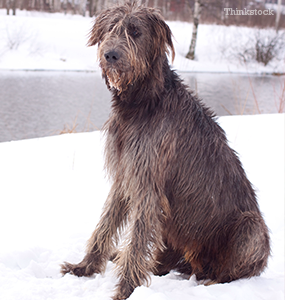Background:
This majestic and enormous breed is truly the stuff of medieval legend. He might have come to Ireland from Greece as early as 1500 B.C. The first written account of the Irish Wolfhound was in 391 A.D. when seven of them were given to the Romans.
In later years Irish Wolfhounds would be coveted by royal families in France and England. They were often presented as gifts just as they had been in Rome. The dogs were obviously useful for hunting but were also considered household pets and excellent company.
In the 1700s Wolfhounds had hunted Ireland’s wolves into extinction. It was nearly the beginning of the end for the breed as demand for Wolfhounds plummeted. The breed certainly would have gone extinct were it not for the efforts of Captain George Graham. Using an Irish Wolfhound named Bran (perhaps the last true Irish Wolfhound left in the world), Graham began a breeding program. He bred Bran with the Great Dane, Scottish Deerhound, Borzoi, and the Tibetan Wolf dog. It took twenty-three years to breathe new life into the breed.
Sizing up:
- Weight: 105 to 180 lbs.
- Height: 30 to 35 inches
- Coat: Wiry, long, double coat
- Color: Gray, brindle, red, black, white, fawn.
- Life expectancy: 6 to 8 years
What’s the Irish Wolfhound like?
Irish Wolfhounds have evolved since their days as war dogs and hunting dogs. Their size can still be intimidating but at heart they’re relaxed family companions who want nothing more than to be loved. Wolfhounds are affectionate towards all people, and extremely child friendly. (Please don’t let children ride the dog.) He would no longer be considered an elite watchdog due to his tendency to be friendly with strangers.
Of course there are circumstances when you should expect the Wolfhound to show aggression. The first is if they feel their family is threatened. Wolfhounds are extremely brave and would literally die for a loved one. Wolfhounds might also show aggression towards other animals, they have a strong prey drive and can’t help but chase and kill animals that run away. You should keep your Wolfhound inside when the cat is out, and should always keep them behind a fence or on a leash.
Wolfhounds are very trainable, but keep in mind they have an independent nature and won’t always wait for you to tell them what to do.
Wolfhounds will adapt to various levels of activity but don’t be fooled into thinking that means they don’t need exercise. A lazy Wolfhound will likely be plagued by health issues and also be more difficult to train. A long walk each day would be a minimum amount of exercise for a Wolfhound. Dog sports or agility training would be even better.
Irish Wolfhounds require a light to moderate level of grooming unless you’re entering them into a show.
Health:
Irish Wolfhounds, unfortunately, have a short lifespan. All breeds have some risk of disease. In the case of the Irish Wolfhound here’s what to watch out for:
- Elbow dysplasia
- Hip dysplasia
- Cardiomyopathy
- Osteosarcoma
- Hyperthyroidism
- Von Willebrand’s disease
- Gastric torsion
- Progressive retinal atrophy
- Bloat (due to their size and deep chests)
Takeaway Points:
- Irish Wolfhounds are a people friendly dog with strong prey instincts.
- Irish Wolfhounds don’t live as long as some other breeds.
- Irish Wolfhounds would be difficult to carry up and down stairs.
If you have any questions or concerns, you should always visit or call your veterinarian – they are your best resource to ensure the health and well-being of your pets.
